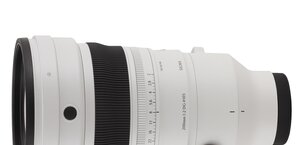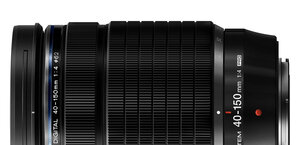Nikon Nikkor AF-S 24 mm f/1.4G ED
4. Image resolution
Let’s check out the results the Nikkor AF-S 24 mm f/1.4G ED had in the frame centre, on the edge of the APS-C/DX sensor and on the edge of full frame as well.
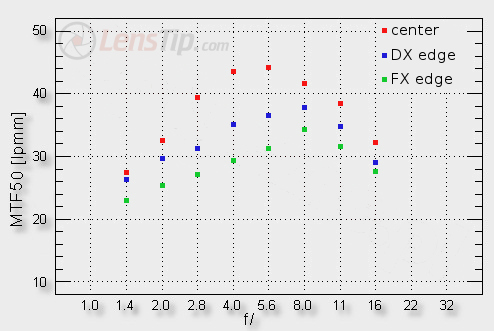
Please Support UsIf you enjoy our reviews and articles, and you want us to continue our work please, support our website by donating through PayPal. The funds are going to be used for paying our editorial team, renting servers, and equipping our testing studio; only that way we will be able to continue providing you interesting content for free. |
- - - - - - - - - - - - - - - - - - - - - - - - - - - - - - - - - - - - - - - - - - - - - - - -
At the maximum relative aperture in the frame centre the lens reaches almost 28 lpmm. It falls short of the decency level but only slightly so. A very similar situation was observed for the Canon 1.4/24 which by f/1.4 wasn’t fully useful either. Fortunately by f/1.6-f/1.8 we get images which are completely acceptable because by f/2.0 aperture the lens gets to almost 33 lpmm. By f/2.0 and f/2.8 the Nikkor fares a bit worse than the Canon – as the latter improved the resolution results very quickly on stopping down. We will write more about the reason of such a performance of the Nikkor at the end of this chapter. Here we only add that the maximum resolution, being on a very high level of 44 lpmm, the tested lens reaches by f/4.0 and f/5.6.
When it comes to the edge of the APS-C/DX sensor, near f/1.4 the Nikkor performs better than the Canon. By f/2.0 both lenses have the same, of course within the margin of error, fully useful results. If you stop down further the Canon is better.
On the edge of the full frame by f/1.4 and f/2.0 apertures the Nikkor gets better results than the Canon, although its performance can be hardly called impressive. By f/2.8 the Canon prevails, however, because at that aperture it is able to give useful images. To reach the same level the Nikkor must be closed down to near f/4.0.
To sum up you can say the results of both 1.4/24 class lenses are similar because although the Nikkor fares better in the area close to the maximum relative aperture, the Canon prevails on stopping down. The Nikkor could have performed much better, especially in the f/1.4-f/2.8 range, it could also have had record resolution values by f/4.0-f/5.6 if only it hadn’t been for one optical aberration – the spherical aberration to be more precise.
It is worth reminding here that this is an axis aberration and it occurs when light rays which strike a lens in various distances from the optical axis, focus in different places. If a lens is not able to produce a perfect focal point for all incoming rays, it won’t be able to give sharp images. Unfortunately the spherical aberration level in the tested Nikkor is high. How does it manifest itself? How visible is it? The crops of our autofocus testing chart, presented below, will help us to answer these questions.
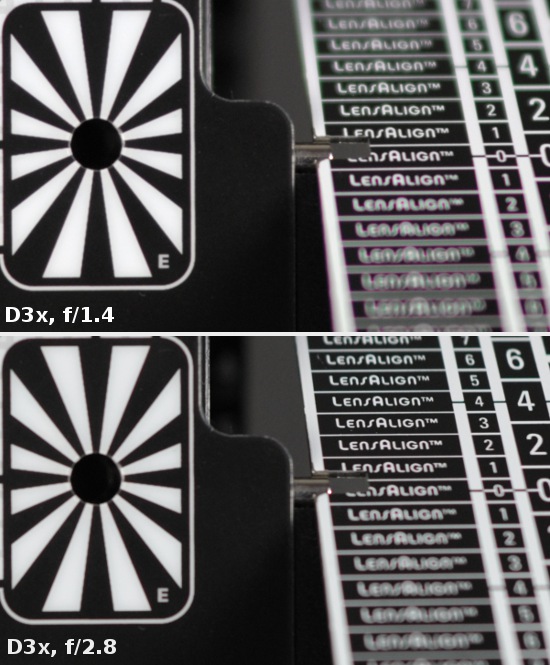 |
The lens was positioned very near the chart so the depth of field was shallow. In the autofocus mode we took one photo by f/1.4. As you can notice the lens didn’t miss. Then, without changing the position of the camera, we switched it into the MF mode and we took photos by f/2.0, f/2.8, f/4.0 and f/5.6. One of them is presented above. It turns out the depth of field centre changes its place on stopping down (so called focus shift) and the change is significant. It is perfectly visible because, as by f/1.4 you see sharp area near ‘0’, by f/2.8 the sharpest point is already near the number ‘3’. Taking photos from closer distances the problem is unfortunately, huge. As by f/1.4 the lens doesn’t show any front or back focus tendency, by f/5.6 we deal with a back focus so huge that in order to correct it we must use the whole AF micro-regulation scale, available in the body! Of course the problem is less pronounced when we photograph objects further away because the depth of field becomes much deeper then. Unfortunately if you buy such an expensive lens manufactured by such a renowned producer you would like it to be free of one of the most basic optical aberrations. To tell you the truth I would have difficulties in reminding myself a lens I’ve had a pleasure of testing, with a higher level of this aberration than that of the Nikkor 1.4/24…
At the end of this chapter we present some crops of our testing chart, taken from the area near the centre of the frame.
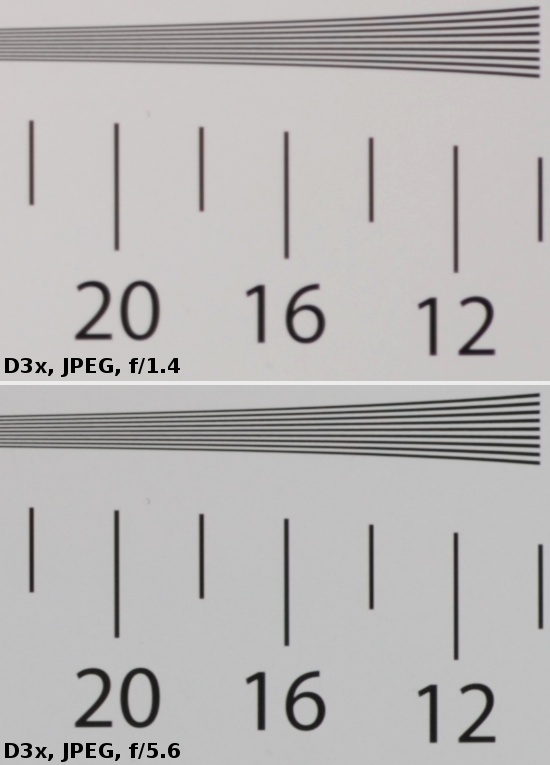 |




